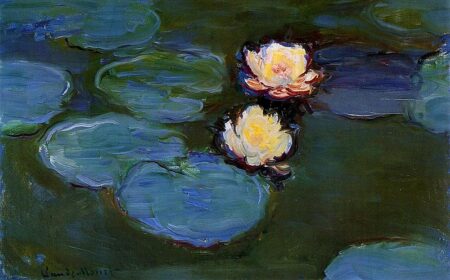Introduction
Claude Monet, a revolutionary figure in the world of art, is celebrated for his iconic contributions to the Impressionist movement. Born on November 14, 1840, in Paris, Monet’s unique approach to capturing the essence of nature has left an indelible mark on the art world. His famous paintings, characterized by their vibrant colors, play of light, and ethereal landscapes, continue to captivate audiences worldwide.
The Impressionist Movement
Monet, along with fellow artists like Pierre-Augusta Renoir and Edgar Degas, played a pivotal role in the development of the Impressionist movement. The movement, which emerged in France during the late 19th century, sought to break away from traditional artistic conventions, focusing instead on capturing the transient effects of light and color in the open air.
Monet’s Innovative Technique
One of the defining features of Monet’s paintings is his revolutionary technique. Rather than meticulously depicting scenes with precise details, Monet opted for a more spontaneous and atmospheric approach. His brushstrokes, often quick and loose, aimed to convey the essence of a scene rather than its specific details. This technique, while initially met with resistance, ultimately became a hallmark of the Impressionist style.
Famous Paintings: Water Lilies

Among Monet’s most famous paintings are his series of Water Lilies. These masterpieces, created between 1897 and 1926, showcase Monet’s deep connection with his Giverny garden. The serene ponds adorned with water lilies and reflections of overhanging willows became his muse. “Water Lilies and Japanese Bridge” (1899) is a prime example of Monet’s ability to translate the beauty of nature onto canvas. The play of light on water, the vibrant colors of the flowers, and the delicate bridge all come together to create a harmonious composition.
Haystacks and Rouen Cathedral Series
Monet’s fascination with capturing the ever-changing effects of light is evident in his series of paintings. The Haystacks series, painted between 1890 and 1891, explores the same subject – haystacks in a field – under various lighting conditions. “Haystacks, End of Summer” (1891) is a stunning example, showcasing the subtle shifts in color and mood.
Similarly, Monet’s Rouen Cathedral series, painted between 1892 and 1894, captures the iconic cathedral at different times of the day and under varying weather conditions. “Rouen Cathedral, The Portal and the Tour d’Albane, Full Sunlight” (1894) is a testament to Monet’s mastery in portraying the interplay of light and shadow in monumental architecture.
Impression, Sunrise
Perhaps the most iconic painting that gave the Impressionist movement its name is Monet’s “Impression, Sunrise” (1872). This masterpiece, depicting the harbor at Le Havre bathed in a hazy sunrise, is a prime example of Monet’s innovative approach to capturing the fleeting effects of light. The loose brushstrokes and the emphasis on mood over details caused a sensation when first exhibited, leading critics to coin the term “Impressionism” in a somewhat derogatory manner. Little did they know that this painting would become a symbol of the movement itself.
Conclusion
Claude Monet’s famous paintings have left an indelible mark on the art world, inspiring generations of artists and art enthusiasts. His innovative approach to capturing the beauty of nature, characterized by loose brushstrokes, vibrant colors, and a keen understanding of light, has made him a timeless figure in art history. The Water Lilies series, Haystacks, Rouen Cathedral series, and “Impression, Sunrise” stand as testaments to Monet’s genius and continue to be celebrated for their beauty and revolutionary spirit. As we admire these famous paintings, we are reminded of Monet’s profound impact on the art world and his enduring legacy as a pioneer of the Impressionist movement.

